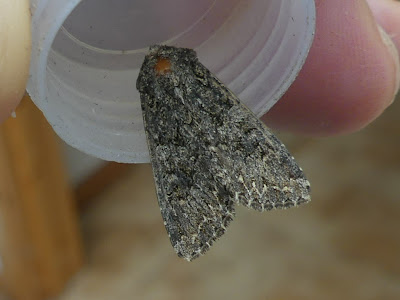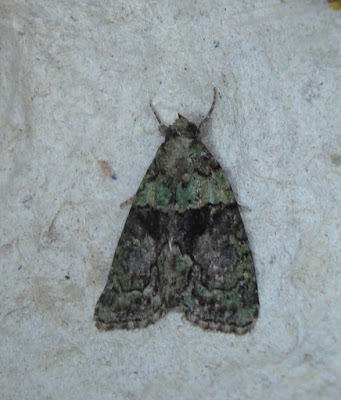Monday, 31 August 2020
Fraxini again
Radnage, Bucks
Sunday, 30 August 2020
National Moth Night no.3
It was a pity that the weather didn't play ball. For the target species I had just the one Red Underwing (Catocala nupta) on the first night with, much as expected, no sign of the crimson ones. Migrants were limited to Udea ferrugalis on the first and second nights and Dark Sword-grass just on the first. Did anyone else have any luck?
Dave Wilton
Westcott, Bucks
Red Underwing? Moth Night no. 3
Mark Griffiths, Garsington, Oxford.
Saturday, 29 August 2020
National Moth Night no.2
 |
| Old Lady, Westcott 28th August |
Dave Wilton
Westcott, Bucks
Friday, 28 August 2020
National Moth Night no.1
 |
| Red Underwing, Westcott 27th August |
There was nothing at all exciting to a wine rope hung out in the (dark) front garden, unlike the previous night when I had Old Lady, Red Underwing and Clifden Nonpareil all at the same time. The prospects for tonight and tomorrow night aren't looking too good at all!
Westcott, Bucks
Death's-head Hawk-moth larvae in Bucks
Thursday, 27 August 2020
Confirmations please
Then a White-point rather than Clay even though the point isn't particularly round. Getting a few of these lately.
Finally Cochylis molliculana? Seems to be now one of the commonest micros I get. (What happened to all the grass moths this year?)
Mark Griffiths, Garsington, Oxford.
Help required - Nutmeg?
Wednesday, 26 August 2020
National Moth Nights
Westcott, Bucks
(19th) Hedya ochroleucana, Cosmopolitan
(20th) Nutmeg
(21st) - nil -
(22nd) Acleris cristana
(23rd) - nil -
(24th) - nil -
(25th) - nil -
The Cosmopolitan (19th) joins Silver-striped Hawk-moth and Convolvulus Hawk-moth as a really good migrant species for the garden this year and we've still not got to the traditional "migrant months" of September and October - I wonder what they'll bring? Nutmeg is an interesting moth here. I rarely get more than a handful and some years it doesn't turn up at all. More often than not it is second-generation individuals like the one on the 20th, when I haven't seen anything of the first brood.
Until last night the lack of new species had been more than made up for by quantity with moths such as Large Yellow Underwing, Setaceous Hebrew Character and Vine's Rustic appearing in good numbers. My garden Large Yellow Underwing count is already well over a thousand and only about a hundred behind the same date in 2019 when I ended up with a record site total of 2,313 individuals for the year.
The MV trap was run on its own last night, well anchored down because of the 45mph gusts from Storm Francis and, even though the catch was much reduced, 22 species turned up. There was also no let-up in the number of wasps which have been a particular garden hazard this year. The full list was as follows: Cochylis molliculana (1), Agriphila tristella (6), Agriphila geniculea (1), Orange Swift (1), Chinese Character (1), Brimstone Moth (3), Dusky Thorn (1), Light Emerald (2), Turnip (3), Large Yellow Underwing (4), Lesser Yellow Underwing (2), Lesser Broad-bordered Yellow Underwing (3), Square-spot Rustic (1), White-point (1), Common Wainscot (3), Copper Underwing (1), Angle Shades (1), Flounced Rustic (14), Rosy Rustic (1), Vine's Rustic (10), Silver Y (1) & Snout (1). The Silver Y was a tiny form gammina (wing length only 12mm) which is generally thought to be a long-distance migrant rather than the larger well-fed moths we get at this time of year which will mostly be locally bred individuals, the progeny of migrants which arrived in May and June.
 |
| Silver Y f. gammina, Westcott 25th August |
Dave Wilton
Westcott, Bucks
Very wet rain.
Before all this I potted up three particular individuals:
Tuesday, 25 August 2020
Second generation Blackneck
Amongst roughly 60 species shared between the two MV lights, the most interesting was a Blackneck. It is quite a common moth in this area but normally flies in June and July and this was my first ever August sighting out of more than 200 records (300+ individual moths). My last record this year was on 4th July, also at Finemere. I see from the flight period graph in the BC Atlas that there are signs of September records and I also remember a trapping session at Otmoor in September 2007 after David Redhead thought he'd seen a similarly late specimen in the area that month but the moth didn't show at the lights.
 |
| Blackneck, Finemere Wood 24th August |
Other species recorded last night included Epermenia falciformis, Cochylis molliculana, Pale Eggar, Hoary Footman, Webb's Wainscot and Tree-lichen Beauty, of which Cochylis molliculana, Hoary Footman and Tree-lichen Beauty may well be additions to the already extensive moth list for Finemere.
Dave Wilton
Westcott, Bucks
Monday, 24 August 2020
A touch of autumn
I had a go with my mercury light last night here in Wolvercote, Oxfordshire - not to much effect, but I did get a few new species, including the attached Centre-barred Sallow, which feels like an early sign of autumn...
Agonopterix assimilella?
Dark Sword-grass and Indian Meal Moth?
I think the first one is my first Dark Sword-grass for several years. Bit worn but I think I see the sword.
The other I think is an Indian Meal moth, Plodia interpunctella which turned up in the house. As you can probably see it's already been in the freezer so if it cannot be ID'd 100% from the photo it can be checked. Not sure though that there is anything else like it.
Mark Griffiths, Garsington, Oxford.
Sunday, 23 August 2020
Webb's Wainscot?
I have been looking at the many wainscots arriving here more closely than usual, following Dave's post about his Cosmopolitan the other day. I wondered if this one, resting near my MV light, is a Webb's - again, following Dave's mention of the species on 19 August. Unusually for me, I have been organised to keep the moth temporarily, so can take more pics if needed. To my eye, the colouring of the first two photos is normal and the lighting on the third has made the moth appear more beige. Help much appreciated, as always. I am near the canal and Cherwell. And thanks again, Dave, for putting me on the alert; I'd not have noticed it otherwise. Martin Wainwright, Thrupp, Oxon
Friday, 21 August 2020
Howe Park Wood, Milton Keynes
 |
| Clifden Nonpareil, Howe Park Wood 20th August |
The damper areas of the wood have quite a lot of aspen so hopefully this is a sign that this stunning moth is now resident here.
Dave Wilton
Westcott, Bucks
Marbled Beauty?
Richard Ellis
Chorleywood
About time...
Steve Goddard
Thursday, 20 August 2020
Chevrons, variation and wear
A few days ago I was momentarily nonplussed to see the following macro-moth with a central chevron:
but closer examination showed at one end was a whitish round mark; i.e., this was a White-point or Clay. Looking at further examples of the Clay, and sometimes of the White-point, one can often see this chevron shape at least faintly (it is effectively the proximal edge of the kidney mark). When seen on the White-point it is very faint and usually slightly lighter than the ground colour (reddish-brown), while on the Clay it is often a pale cream colour and stands out more (see also below). Indeed the illustration by Richard Lewington in the Waring & Townsend field guide shows a pale area adjacent to the white spot for the Clay, but not for the White-point. The Clay is reputedly more variable in colour, and may be pale as in this case, but the white spot is usually small and/or tear-drop shaped. However, to me the overall size and shape, as well as the shape of the white spot, etc. make this 'chevron' specimen more like the White-point than the Clay - so is this another case of variation and/or wear making identification difficult?
John Thacker, Harwell
Cosmopolitan
 |
| Cosmopolitan, Westcott 19th August |
Dave Wilton
Westcott, Bucks
Wednesday, 19 August 2020
lime speck pug
a very worn pug caught last night,when it settled outside of the trap shape wise it looked like a lime speck pug.not sure if it is possible to id it from this photo .can anyone confirm please.
Mike Banbury oxon
MV Bulbs - ballasted or not?
Hi
I'm in the process of ordering a new 125w MV bulb for my trap. I have a 125w ballast made by Paul Batty and it all works fine, if a little hot sometimes.
I noticed on EBAY you can buy BHPM 160w MV bulbs that can be plugged directly into the mains without a ballast. Has anyone tried this? Do you notice any difference in moth numbers or variety? All thought welcome. Thanks
Andrew Cornick SU28
A pug and a micro
This week in Chorleywood.
When I ran the lights in my back garden on the 16th August I was impressed by how small quite a few of the examples of several species were, eg Tree-lichen Beauty and Cydalima perspectalis.
Species notably lower in numbers compared to the 7th August included Dun-bar, Yellow Shell, Lesser Broad-bordered Yellow Underwing, Holly Tortrix, Mother of Pearl, Brimstone, Endotricha flammealis and Cydalima perspectalis.
For the second time in a row I took a single Water Veneer, a species I associate with large numbers whenever it does appear.
Tachystola acroxantha continues to turn up, all the way through from May.
When I cut open a wind-fall apple this fat little caterpillar hopped out:
Codling Moth, aka Cydia pomonella. Interestingly, I also caught the adult at the lights this week. Within 24 hours it was attempting spin a cocoon in which to hibernate, which apparently they do as larvae, not pupae.













































